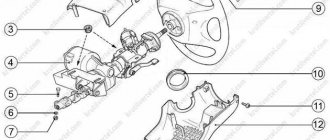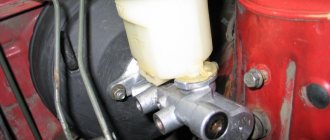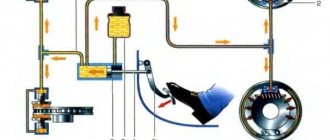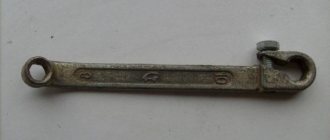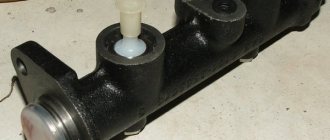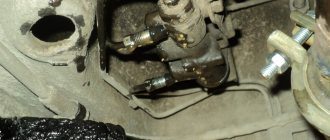Device, principle of operation
So, the driver stops the car by pressing the brake pedal. The latter affects the brake force booster, and the latter acts on the GTZ, which compresses the fluid in the lines.
Under the influence of the GTZ force, the liquid is compressed and passes into a zone with minimal pressure. These are tubes, and then - working mechanisms. The brake fluid presses on the drive and the caliper compresses the pads. When the pedal pressure is released, the pressure in the brake booster decreases. Springs in the mechanism release the pads. The liquid moves back into the expansion tank - into the area where the pressure is minimal.
The movement of brake fluid is carried out through copper tubes. The latter are connected to the main brake cylinder and laid along the bottom of the car to the brake mechanisms. The connections of the tubes to the mechanisms and to the GTZ are made in the form of threads - this ensures maximum reliability. After all, the pressure in the line can be quite high.
To increase the reliability of the systems, the tubes are connected to the GTZ diagonally. This makes it possible to use the brake if the latter fails. For example, from the GTZ one of the tubes connects the front left brake mechanism and the rear right one. Another tube directs fluid to the front right and rear left wheels. To ensure that the pressure in the system does not exceed the permissible value, a pressure regulator is installed at the places where all the tubes are connected. In common parlance he is called a “sorcerer”.
When to change hoses
The service life of brake rubber pipes is about 3 years if the car is used regularly. A poor-quality hose may leak after six months or 2-3 thousand kilometers, or even earlier.
In order not to lose the brakes while driving and not become the culprit of an accident, the owner of the “seven” must constantly monitor the technical condition of the flexible hoses and immediately change them if the following signs are detected:
- when many small cracks appear, indicating critical wear of the rubber shell;
- in case of detection of wet liquid stains, which most often appear near the very tips;
To identify cracks, the pipe must be bent by hand, otherwise defects may go unnoticed. A friend of mine discovered a fistula in the hose in this way, and quite by accident - he was about to change the upper ball joint, while disassembling it, he touched a rubber tube with his hand, and brake fluid flowed from there. Until then, the hose and surrounding undercarriage components remained dry.
If you ignore the above signs and drive further, the flexible line will break completely. Consequences: the fluid will quickly leak out of the circuit, the pressure in the system will drop sharply, and the brake pedal will fall to the floor when pressed. To minimize the risk of a collision in the event of a brake system failure, take the following steps promptly:
- The main thing is don’t get lost and don’t panic. Remember what you were taught in driving school.
- Pull the handbrake lever to the maximum - the cable mechanism operates independently of the main fluid system.
- Stop the engine without pressing the clutch pedal or changing the current gear.
- At the same time, monitor the road situation and use the steering wheel, trying to avoid collisions with other road users or pedestrians.
The advice regarding turning off the engine is only suitable for Zhiguli cars of the VAZ 2101-07 series, which are not equipped with hydraulic or electric power steering. In modern cars, you should not turn off the engine - the steering wheel will instantly become heavy.
Video: diagnostics of flexible brake pipes
Signs that replacement is needed
Anyone, even an inexperienced motorist, can independently and without much effort determine whether it is worth changing the brake lines. Usually a complete replacement is necessary if there is fluid leakage from the system or if the drums have overheated. It is also advisable to replace the tube if the pedal free play or braking distance has increased. Replacing the brake pipe is also recommended if the pads have uneven wear. This means that they work under different pressures.
Symptoms indicating a malfunction
The main signs of poor brake performance can be caused by all components in this circuit: rear or front circuits with pipes, malfunctions of the master cylinder or poor pedal adjustment:
- Unusual behavior of the car when braking or a “soft” brake pedal indicates that the pedal requires adjustment or that air has entered the system and needs to be bled.
- The corresponding indicator light comes on, the pads may be worn out or the entire system needs to be bled.
- There are stains under the bottom and upon visual inspection, leaks are visible. Somewhere the pipe fitting is leaking hydraulic fluid, or the cuffs are worn out.
- When checking the pressure in the circuits, it does not coincide with the control figures - the main roller is unstable, namely, the fitting unevenly bypasses the liquid or it flows in one of them. The cause may also be poor quality hydraulic fluid; replacing and pumping in this case may help.
If some of these signs are detected, there is no need to rush to conclusions that the master brake cylinder needs to be replaced; perhaps bleeding the system can help, but even if this does not give results, do not rush to change it, perhaps it can be repaired. You can always find spare parts on sale in the form of a master brake cylinder repair kit, which may include: a fitting, pistons, cuffs, springs, retaining rings, etc.
Reasons for tube failure
As a rule, on most cars, the brake line becomes unusable due to corrosion. It is not uncommon for old pipes to develop cracks. Brake fluid then slowly leaks out of these cracks. The tubes are made of copper and, it would seem, should not corrode, but this is not the case. Corrosion eats up highways, and we also need to add to this the negative influences of the external environment. The environment has a particularly negative impact on the metal of pipes in winter, when utility services spray roads with caustic reagents.
Also, one of the reasons for failure is poor fastening of the line to the body. Often the line is fixed to the bottom of the car and is not protected by anything. In winter, the bottom of the car can catch various obstacles and as a result the tube cracks or breaks. Also, if the element constantly moves along with the body, then over time a kink appears at the place where the line bends. The part is easily damaged.
How is the replacement performed?
The process of replacing a brake pipe will require the car owner to have plumbing skills and abilities. You will have to use traditional and special tools. Tube repair is performed when it is impossible to replace the line with a new one.
To replace, unscrew the tube from the brake cylinder, and the opposite end is unscrewed from the master brake cylinder. Then a new product is purchased. The tube can be purchased at auto parts stores, but it is important to remember the thread pitch. For foreign cars, this is a 10 thread with a pitch of 1. This spare part already has two nuts and is flared. The length of the tubes on sale may vary, but it must be selected based on the vehicle. So, on some car models the part may be laid with a reserve, but on another model there is no such reserve. Replacing a brake pipe involves unscrewing the old one and screwing a new one in its place.
How to change front tubes?
To operate you will need a special key. It is a tool with a bolt for tightening. The key resembles a spanner, but there is no need to purchase a cheap product in stores. Such keys are made of soft alloys that cannot withstand heavy loads. The nut on the tube is made of steel - the key easily fails, and the edges on the nut get licked off. Then unscrewing and tightening such a part can be a big problem. The nuts are tightened tightly enough that you can water them with WD-40, but you shouldn’t heat them. When heated, the brake fluid boils; due to the high pressure in the system, the hoses can rupture, especially if they are old.
Master cylinder repair
After the master brake cylinder has been removed, it is worth inspecting for mechanical damage; if there is none, you need to disassemble it and replace the failed spare parts with those found in the repair kit. After disassembling the master brake cylinder, in any case, you must change all the rubber parts - cuffs, etc. The principle of disassembly is simple:
- Having previously secured it in a vice, unscrew the fluid supply fittings from the body;
- use a screwdriver to remove the retaining ring;
- Carefully disassemble and remove cuffs, pistons, springs and other spare parts.
Instructions
Here's how to replace brake pipes on a VAZ 2110. First of all, you need to remove the wheel on the side where the pipe will be replaced. Next you need to find the brake hose. It is connected at one end to the caliper, and at the other end to the tube. Using a special wrench, carefully unscrew the nut on the tube, holding the hose with another wrench. The second end of the tube is connected to the GTZ. In the same way, unscrew the tube nut from the brake cylinder.
Then a new one is screwed in place of the old line. First, tightly wrap the tube to the GTZ, and then to the brake hose on the caliper. Before connecting the line to the system, you should lay the pipe along the body the way it was installed. At this point, the replacement of brake pipe 2110 can be considered complete. But since the system has been depressurized for some time, the brakes should be bled. It is not necessary to fully bleed the brakes. This is done only where there has been a replacement. Remember that the tubes are connected diagonally.
For example, if the right brake pipe at the front was replaced, then you should start bleeding the system from the rear left wheel and vice versa if the left front pipe was changed.
Which spare parts are better
The main problem when choosing brake hoses is the saturation of the market with counterfeit parts of low quality. Such eyeliners do not last long, quickly become covered with cracks or begin to leak near the pressed tips literally a week after installation. How to choose the right rubber pipes:
- Do not buy cheap hoses without packaging, sold individually. Usually the front tubes come in pairs.
- Carefully examine the metal surfaces of the fastening fittings - there should be no traces of rough machining on them - nicks, grooves from a cutter and similar defects.
- Examine the markings on the rubber tube. As a rule, the manufacturer puts its logo and indicates the product catalog number, which matches the inscription on the packaging. Some hieroglyphs clearly indicate the origin of the spare part - China.
- Try stretching the pipe. If the rubber stretches like a hand expander, refrain from purchasing it. Factory hoses are quite stiff and difficult to stretch.
An additional sign of a quality product is 2 pressing contours instead of one. Counterfeit pipes are not made with such care.
Trusted brands that produce brake pipes of decent quality:
- BRT - Balakovo Rubber Products Plant;
- DAAZ - Dimitrovgrad aggregate;
- KRAFTTECH;
- Fenox.
Hoses from the Balakovo plant are considered original. The parts are sold in transparent packaging with a hologram, the marking is in relief (molded along with the rubber product), and not a colored inscription with paint.
Along with a set of front pipes, it is worth buying 4 new O-rings made of copper 1.5 mm thick, since the old ones are probably flattened from strong tightening. It also doesn’t hurt to make sure there are fixing brackets screwed to the calipers - many drivers don’t bother installing them.
Video: how to distinguish counterfeit parts
Rear end
There is nothing complicated here, except that the line is longer and it is connected as follows - the longer part of the tube is connected to the GTZ and screwed to the “sorcerer”. Then the “sorcerer” is connected with a short tube to the brake mechanism on the wheel.
Replacement of the rear brake pipe is carried out as follows. If there is an overpass or hole, then you will not need to remove the wheel. First, apply liquid wrench to all threaded connections, then wait a little. After this, use a Phillips screwdriver or other suitable tool to unscrew the screws securing the tubes to the car body. After this, use a suitable wrench to unscrew the two fittings securing the tube to the brake hose and to the regulator. The element is removed and a new one is installed in its place. If the long line to the “sorcerer” is damaged, then the actions are similar, only unscrew the fitting from the GTZ and from the regulator.
After the replacement, you must remember to add brake fluid to the expansion tank to the required level and be sure to bleed the system, since it has taken in air and the braking process will be ineffective. If the front brake pipes on the left were replaced, then there is no need to bleed another line.

